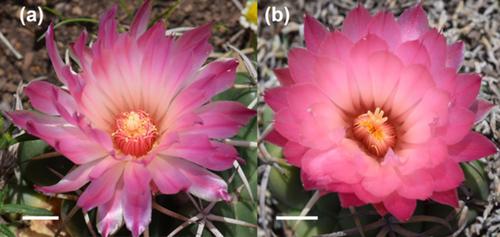当前位置:
X-MOL 学术
›
Plant Species Biol.
›
论文详情
Our official English website, www.x-mol.net, welcomes your feedback! (Note: you will need to create a separate account there.)
Flower biology of the cactus Coryphantha elephantidens in the tropical dry forest of Central Mexico
Plant Species Biology ( IF 1.4 ) Pub Date : 2020-11-01 , DOI: 10.1111/1442-1984.12303 Concepción Martínez‐Peralta 1 , Angélica Martínez‐Zavala 2
Plant Species Biology ( IF 1.4 ) Pub Date : 2020-11-01 , DOI: 10.1111/1442-1984.12303 Concepción Martínez‐Peralta 1 , Angélica Martínez‐Zavala 2
Affiliation

|
Floral traits and sexual systems in angiosperms are strategies that enhance outcrossing within hermaphrodite flowers and among individuals in a population. Sexual systems with unisexual flowers have also evolved among angiosperms, resulting in sex specialization. Furthermore, the interaction of floral traits and floral visitors determines successful plant reproduction. Globose cacti are bee pollinated, and variation in the diversity of their pollinator assemblages is strongly associated with floral phenotype. Our objective was to describe the floral biology of the cactus Coryphantha elephantidens and to determine its relationship with pollinators. Floral traits were studied by direct observations in live and fixed flowers. The breeding system was determined using two estimators based on floral morphology: pollen grains to ovules per flower (P/O) ratio and outcrossing index. Pollination treatments were conducted to determine the mating system. Floral visitors were recorded using direct observation. Flowers of C. elephantidens are variable in color, protandric, herkogamous and nectarless. Estimators of the breeding system indicated xenogamy, which is consistent with the obligate outcrossing revealed by the pollination experiment. Thirty‐seven percent of the plants have female flowers that do not produce pollen, making this population functionally gynodioecious. Both fruit and seed set were high compared to other globose cacti. Pollinators included eight species of native bees, a more diverse pollinator assemblage than other globose cacti. Given the high pressure on pollen due to functional gynodioecy, nectarless flowers, an outcrossing mating system, and the necessity of pollinators to set seeds, we concluded that native bees are highly efficient pollinators that play a crucial role in the sexual reproduction of C. elephantidens.
中文翻译:

墨西哥中部热带干旱森林仙人掌花科植物的花生物学
被子植物中的花卉特征和性系统是增强雌雄同体花内和种群中个体之间异型杂交的策略。在被子植物之间还发展了具有单性花的性系统,从而导致了性别专一化。此外,花卉性状和花卉访客的相互作用决定了植物的成功繁殖。球形仙人掌是蜜蜂授粉的,其授粉媒介多样性的多样性与花的表型密切相关。我们的目的是描述仙人掌花冠象的花生物学并确定其与传粉媒介的关系。通过直接观察活花和固定花来研究花的性状。育种系统是根据花卉形态使用两个估算器确定的:花粉粒对每花的胚珠比率(P / O)和异交指数。进行授粉处理以确定交配系统。使用直接观察记录花访客。C. Elephantidens的花朵颜色可变,原色,无性和无花蜜。繁殖系统的估计者表示异种,这与授粉实验揭示的专性异交相一致。37%的植物具有不产生花粉的雌花,因此该种群在功能上属于雌性。与其他球状仙人掌相比,果实和种子结实都高。授粉媒介包括八种本地蜜蜂,与其他球状仙人掌相比,传粉媒介的多样性更大。鉴于功能性生殖,无花蜜,异交的交配系统以及对传粉者结实的必要性,花粉承受着巨大的压力,我们得出结论,本地蜜蜂是高效的传粉者,在象鼻虫的有性繁殖中起着至关重要的作用。。
更新日期:2020-11-01
中文翻译:

墨西哥中部热带干旱森林仙人掌花科植物的花生物学
被子植物中的花卉特征和性系统是增强雌雄同体花内和种群中个体之间异型杂交的策略。在被子植物之间还发展了具有单性花的性系统,从而导致了性别专一化。此外,花卉性状和花卉访客的相互作用决定了植物的成功繁殖。球形仙人掌是蜜蜂授粉的,其授粉媒介多样性的多样性与花的表型密切相关。我们的目的是描述仙人掌花冠象的花生物学并确定其与传粉媒介的关系。通过直接观察活花和固定花来研究花的性状。育种系统是根据花卉形态使用两个估算器确定的:花粉粒对每花的胚珠比率(P / O)和异交指数。进行授粉处理以确定交配系统。使用直接观察记录花访客。C. Elephantidens的花朵颜色可变,原色,无性和无花蜜。繁殖系统的估计者表示异种,这与授粉实验揭示的专性异交相一致。37%的植物具有不产生花粉的雌花,因此该种群在功能上属于雌性。与其他球状仙人掌相比,果实和种子结实都高。授粉媒介包括八种本地蜜蜂,与其他球状仙人掌相比,传粉媒介的多样性更大。鉴于功能性生殖,无花蜜,异交的交配系统以及对传粉者结实的必要性,花粉承受着巨大的压力,我们得出结论,本地蜜蜂是高效的传粉者,在象鼻虫的有性繁殖中起着至关重要的作用。。



























 京公网安备 11010802027423号
京公网安备 11010802027423号